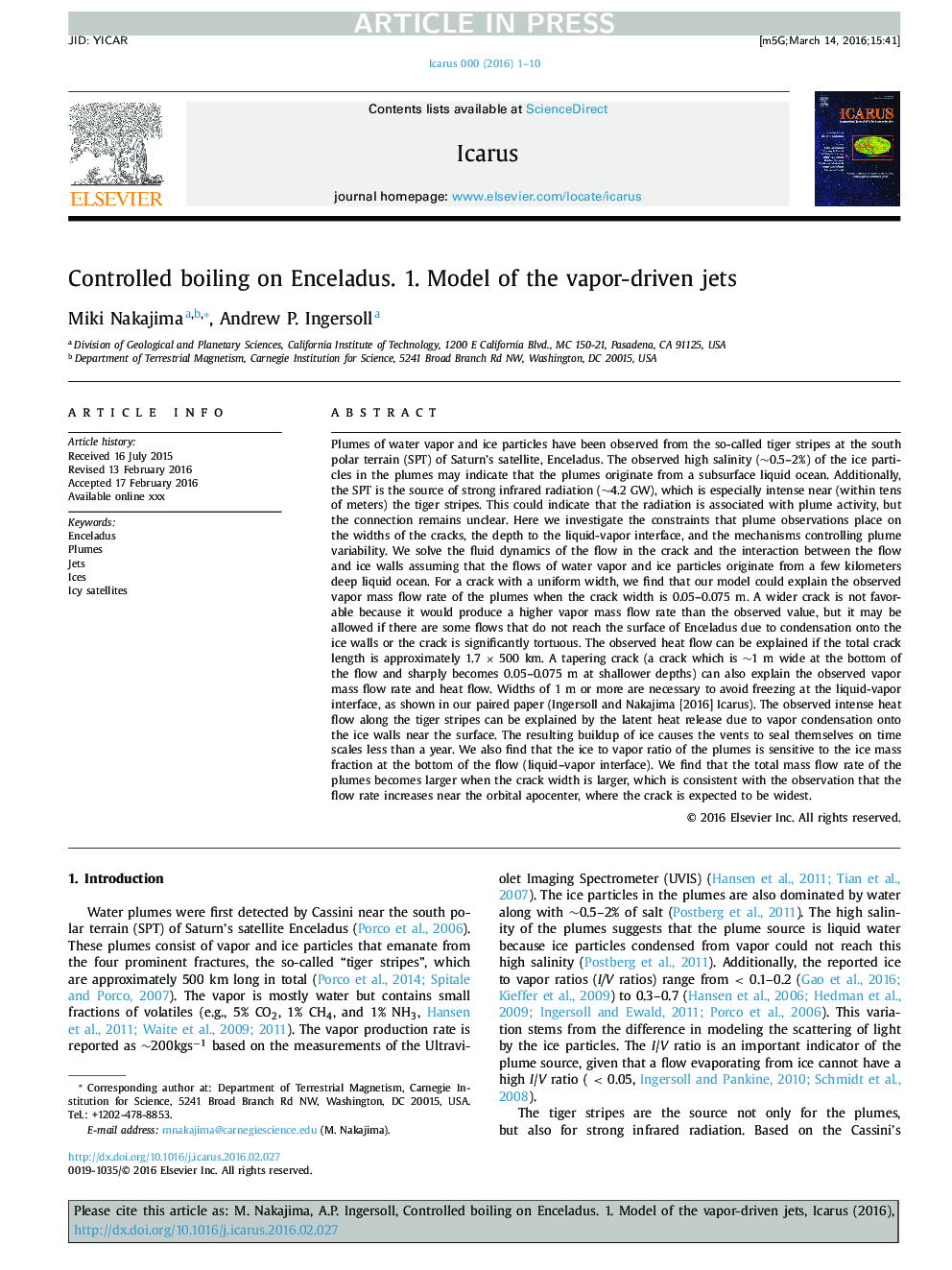| کد مقاله | کد نشریه | سال انتشار | مقاله انگلیسی | نسخه تمام متن |
|---|---|---|---|---|
| 8135325 | 1523518 | 2016 | 10 صفحه PDF | دانلود رایگان |
عنوان انگلیسی مقاله ISI
Controlled boiling on Enceladus. 1. Model of the vapor-driven jets
ترجمه فارسی عنوان
جوش بر روی انسلادوس کنترل شده است. 1. مدل جت های هدایت شده بخار
دانلود مقاله + سفارش ترجمه
دانلود مقاله ISI انگلیسی
رایگان برای ایرانیان
کلمات کلیدی
انسلادوس، آلوئه ورا، جت، ایسس، ماهواره یخی،
موضوعات مرتبط
مهندسی و علوم پایه
علوم زمین و سیارات
علوم فضا و نجوم
چکیده انگلیسی
Plumes of water vapor and ice particles have been observed from the so-called tiger stripes at the south polar terrain (SPT) of Saturn's satellite, Enceladus. The observed high salinity (â¼0.5-2%) of the ice particles in the plumes may indicate that the plumes originate from a subsurface liquid ocean. Additionally, the SPT is the source of strong infrared radiation (â¼4.2Â GW), which is especially intense near (within tens of meters) the tiger stripes. This could indicate that the radiation is associated with plume activity, but the connection remains unclear. Here we investigate the constraints that plume observations place on the widths of the cracks, the depth to the liquid-vapor interface, and the mechanisms controlling plume variability. We solve the fluid dynamics of the flow in the crack and the interaction between the flow and ice walls assuming that the flows of water vapor and ice particles originate from a few kilometers deep liquid ocean. For a crack with a uniform width, we find that our model could explain the observed vapor mass flow rate of the plumes when the crack width is 0.05-0.075Â m. A wider crack is not favorable because it would produce a higher vapor mass flow rate than the observed value, but it may be allowed if there are some flows that do not reach the surface of Enceladus either due to condensation on the icy walls or the tortuosity of the crack. The observed heat flow can be explained if the total crack length is approximately 1.7 Ã 500 km. A tapering crack (a crack which is â¼1Â m wide at the bottom of the flow and sharply becomes 0.05-0.075Â m at shallower depths) can also explain the observed vapor mass flow rate and heat flow. Widths of 1 m or more are necessary to avoid freezing at the liquid-vapor interface, as shown in our paired paper (Ingersoll and Nakajima [2016] Icarus). The observed intense heat flow along the tiger stripes can be explained by the latent heat release due to vapor condensation onto the ice walls near the surface. The resulting buildup of ice causes the vents to seal themselves on time scales less than a year. We also find that the ice to vapor ratio of the plumes is sensitive to the ice mass fraction at the bottom of the flow (liquid-vapor interface). We find that the total mass flow rate of the plumes becomes larger when the crack width is larger, which is consistent with the observation that the flow rate increases near the orbital apocenter, where the crack is expected to be widest.
ناشر
Database: Elsevier - ScienceDirect (ساینس دایرکت)
Journal: Icarus - Volume 272, 1 July 2016, Pages 309-318
Journal: Icarus - Volume 272, 1 July 2016, Pages 309-318
نویسندگان
Miki Nakajima, Andrew P. Ingersoll,
